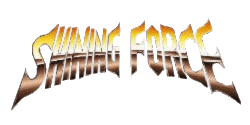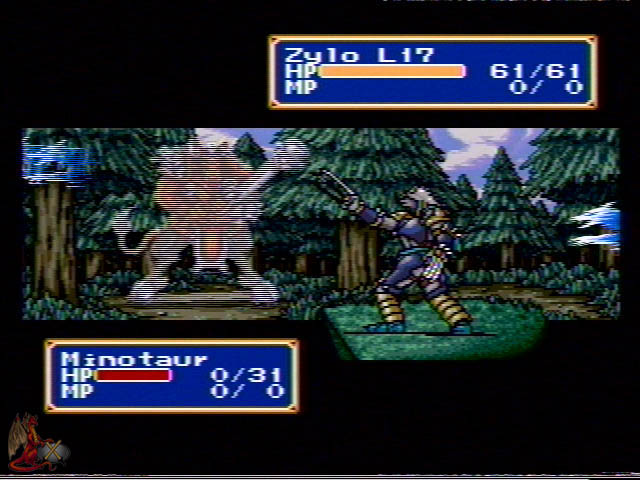|
|

|
BATTLE SYSTEM
|

|
INTERACTION
|

|
ORIGINALITY
|

|
STORY
|

|
MUSIC & SOUND
|

|
VISUALS
|

|
CHALLENGE
|
Variable
|
COMPLETION TIME
|
~25 hours
|
|
OVERALL
2.5/5
|
Rating definitions
|
|
|
Tactical RPGs were all-but unknown in the English- speaking world in 1993. Warsong had failed, and the early Fire Emblem titles were being resoundingly ignored by Nintendo of America. Sega of America decided to take a bit of a chance in translating the original Shining Force for English-speaking audiences. While the results are not terrible, the advances made in Tactical RPGs since make clear just how rudimentary Shining Force 1 is.
As befits a Tactical RPG the battle system is the centerpiece of Shining Force. For a later title this could be easily described as ‘classic Shining Force style,’ but being that this is the original a bit of further description is necessary. The player controls up to 12 characters, ranging from swordsmen to bird warriors to a steam tank to a floating jellyfish to a samurai, all of whom are moved individually and attack enemies within range. Magic is gained through advancing levels, and its uses are to attack and heal allies primarily. At level 10 the player is given the option of promoting each character, though this is discouraged in favor of waiting a bit because the game considers level 1 promoted to be level 11 in terms of experience gained from enemies – and because in Shining Force 1 promotion actually lowers stats just at the point when enemies begin to get stronger. Characters can be killed with the only penalty being the money required to bring them back to life later, except for the leader, Max. If Max goes down the battle is lost and must be retried (no Game Over screen, just half of the current cash is gone).
 I Was a Teenage Werewolf
I Was a Teenage Werewolf
|
|
Shining Force’s story is resoundingly unimpressive. The kingdom of Guardiana is being attacked by soldiers from Runefaust over materials necessary for the resurrection of a nasty demon named Dark Dragon. Once they have joined characters typically never figure into the plot again, leaving Max and his advisor Nova to be the only characters with many scenes. Replay can be justified by trying out different characters in a new play, but there are no side quests or optional areas. Thus replay is not a serious factor in enjoyment of the game.
Music is mostly passable, but unremarkable. The better tracks are almost never played while mediocre music is played far too much. Sound effects are early Genesis fare, and thus nothing impressive. Visuals outside of the battle actions that are a trademark of Shining Force are also early Genesis quality, though the in-battle actions are nice enough to make the overall experience pleasing for this era of graphical ability.
The early development of Shining Force really shows through in a number of annoying details that make playing it more of a chore than necessary. Interaction is convoluted, with any items acquired outside of battle only being given to Max. Once Max has four items no more can be acquired, until the player goes through the laborious process of giving them to someone else in the party. In battle 100 experience points are required to gain a level. The problem here lies in the inability of the game to carry over experience – if one gains 40 experience points while at 95, the counter resets to 0. Items purchased in shops are not so easy to assign to the proper characters as would be desirable, and require the player to guess whether they will be useful for characters not currently in the fighting party, because only members of the fighting party can be assigned items when purchasing such.
 Contrary to popular belief, Cerberus loves seafood, not brimstone.
Contrary to popular belief, Cerberus loves seafood, not brimstone.
|
|
Perhaps the most annoying aspect of Shining Force is its difficulty, however. There are difficult battles, certainly. Max is made the target of many enemy attacks because of his vital status: his defense goes up at a good enough rate to not make him too endangered however. The AI of Shining Fore is atrocious, however. In many battles enemies will not move until the player has passed a certain point. They will not move even when a character with an attack range of 2 or 3 is hitting the enemy, and thus will die incredibly easily. Bosses have this ailment also, so badly that the programmers tried to alleviate it by having bosses inexplicably regain HP every round. Seekers of a Fire Emblem-style challenge will not find it here.
Shining Force would go on to much better things than this generally unimpressive opening entry. So would the developers at what has become Camelot, who it is hoped will eventually issue another RPG alongside the many Mario sports titles they have developed recently. At this time they had yet to master their craft however, and Shining Force 1 fails to impress.
Review Archives
|









